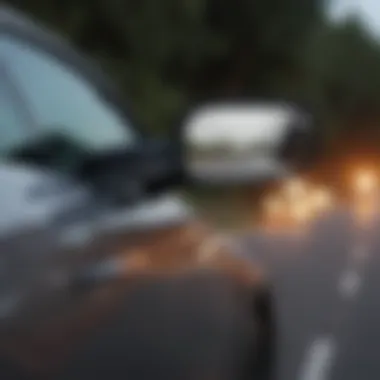Understanding Car Side Mirror Blind Spot Sensors


Intro
Cars today have more features than ever before. One of these features is the blind spot sensor, which is found in many modern vehicles. This technology plays an important role in road safety. Drivers are often unaware of other vehicles in their blind spots, leading to accidents. Therefore, understanding how these sensors work and their benefits is crucial for automotive enthusiasts and buyers.
Blind spot sensors enhance driving safety by alerting drivers to vehicles that may not be visible in the mirrors. This is especially helpful during lane changes. The sensors are integrated into the side mirrors, making it easier to see potential hazards. In addition to improving safety, these sensors also influence purchasing decisions when consumers are looking at vehicles.
Vehicle Purchasing Behavior
As consumers choose vehicles, various factors influence their decisions. Understanding these factors can help manufacturers and dealers market their cars more effectively.
Factors Influencing Vehicle Purchases
- Safety Features: Modern buyers prioritize safety technology. Blind spot sensors are increasingly seen as essential.
- Price and Affordability: Buyers consider the cost of the vehicle. A good balance of features and price is important.
- Fuel Efficiency: With rising fuel prices, many consumers look for cars that offer better mileage.
- Brand Reputation: Consumers trust brands that are known for quality and safety innovations.
- Technology Availability: Features like blind spot sensors attract tech-savvy buyers.
Demographics of Buyers
Different demographic groups show varied preferences when purchasing cars. Age, income, and lifestyle can greatly affect the choices made. Younger buyers tend to seek out newer technologies, while older buyers may prioritize comfort and reliability. The following insights can clarify these trends:
- Millennials: Often look for features that enhance tech connectivity. They value safety but also consider design and brand image.
- Older Drivers: May desire safety features but also appreciate traditional aspects like comfort and ease of use.
Market Insights and Analysis
Understanding the market is essential for any automotive professional. Insights into consumer behavior and competitor strategies can guide effective positioning of vehicles.
Consumer Behavior Analysis
Consumers today are more informed than ever. They often conduct extensive research before visiting showrooms. Online reviews and comparisons greatly influence decisions.
- Social Media Impact: Platforms like Facebook and Reddit provide forums for discussion and feedback on vehicle features, including blind spot sensors.
- Online Reviews: Sites like Wikipedia and Britannica often serve as resources for understanding technology like blind spot sensors.
Competitor Analysis
Manufacturers are in constant competition to provide the best safety features. Understanding who your competitors are and how they market their blind spot technology is critical.
- Leading Brands: Companies like Toyota and Honda frequently integrate advanced sensor technologies into their vehicle lines, positioning themselves as leaders in safety.
- Emerging Technologies: Stay aware of new entrants in the market who may innovate in ways that challenge traditional offerings.
"Blind spot sensors are becoming indispensable in modern vehicles, affecting both consumer choice and vehicle safety standards."
By grasping the market dynamics and consumer preferences, those in the automotive sector can better navigate this evolving landscape.
Preface to Blind Spot Monitoring Systems
Blind spot monitoring systems have become essential safety features in modern vehicles. They serve a vital role in enhancing road safety by providing drivers with additional awareness of their surroundings. This is especially important during lane changes or merges where visibility may be limited. The purpose of blind spot monitoring systems extends beyond mere convenience; they can be seen as a necessity in an increasingly crowded and demanding driving environment.


Definition and Purpose
Blind spot monitoring systems primarily aim to detect vehicles that may not be visible through traditional mirrors. These systems utilize sensors located on the sides of the vehicle, often integrated into side mirrors. When another vehicle enters the blind spot zone, the system alerts the driver through visual or audible signals. This immediate feedback can significantly reduce the risk of accidents caused by unaware maneuvers.
In practical terms, the main purpose of blind spot sensors is to enhance situational awareness for drivers. They act as a second set of eyes, monitoring areas that might escape a driver's direct line of sight. This capability is critical, particularly in urban settings or on highways where rapid changes in vehicle position can occur without warning.
Historical Context of Blind Spot Sensors
The development of blind spot monitoring technology reflects broader trends in automotive safety innovations. Early systems appeared in the 2000s, utilizing basic radar technology to alert drivers of vehicles in adjacent lanes. As automotive technology advanced, so did the complexity and effectiveness of these systems. Newer models now often incorporate cameras and advanced algorithms, improving detection accuracy and response time.
Moreover, the increasing implementation of such systems corresponds with a growing awareness of road safety issues. Statistics indicate that many accidents occur due to lane change errors, primarily when drivers are unaware of surrounding vehicles. Recognizing this, manufacturers began to integrate blind spot monitoring as standard features in various car models.
This evolution in blind spot monitoring showcases an ongoing commitment to reduce accidents and enhance driver confidence. As technology progresses, the effectiveness of these systems also improves, ultimately leading to safer roads for all users.
Technology Behind Car Side Mirror Blind Spot Sensors
The integration of technology in car side mirror blind spot sensors greatly influences how drivers navigate their environments. These sensors leverage advanced principles of detection to enhance safety measures while driving. By understanding the technology behind these devices, we gain insights into their effectiveness and reliability.
Sensor Types and Mechanisms
Car side mirror blind spot sensors typically utilize various types of sensors for their functionality. Ultrasonic sensors, for instance, are commonly used due to their ability to detect objects within a defined range. They emit sound waves and measure the time it takes for the waves to bounce back. This method is effective at short distances, making it ideal for blind spot monitoring.
Another prevalent type is radar sensors. Radar operates by sending and receiving radio waves, which allows it to detect objects at greater distances compared to ultrasonic sensors. This technology is vital for vehicles equipped with advanced driver assistance systems.
The choice of sensor type can affect performance in different driving conditions. For example, while radar works well in various weather conditions, ultrasonic sensors might struggle in adverse conditions, like heavy rain or fog. Understanding these distinctions is important for consumers and manufacturers alike.
Installation Process of Sensors
Preparation for Installation
Preparation for installation is a critical step in the process of integrating blind spot sensors. This stage involves assessing the vehicle's specifications to determine the best sensor type and location. Ensuring compatibility with the vehicle's electrical system is also essential.
The key characteristic of thorough preparation is that it mitigates potential issues during installation. A popular choice in this preparation phase is consulting manufacturer guidelines or professional services. This strategy minimizes risks associated with improper installations, which can lead to sensor malfunctions.
Furthermore, unique features of the preparation phase, such as creating a detailed plan and sourcing quality parts, are indispensable. These steps enhance the reliability of the installation process. Neglecting this phase can result in significant disadvantages, including faulty operation of sensors, which undermines the purpose of enhancing safety.
Step-by-Step Installation Guide
The step-by-step installation guide simplifies the complex process of installing blind spot sensors. A well-structured guide can provide clarity and streamline the installation process. One beneficial aspect of this guide is that it offers an organized approach, reducing the likelihood of overlooking important steps.
Unique features of a typical installation guide include clear diagrams and detailed instructions. These elements are fundamentally advantageous in ensuring that users follow the necessary steps effectively. However, a disadvantage is that complex vehicles may require specific adjustments, making it necessary for users to have basic mechanical skills or knowledge.
Benefits of Side Mirror Blind Spot Sensors
Understanding the benefits of side mirror blind spot sensors is crucial for evaluating their effectiveness in modern vehicles. As safety features continue to evolve, these sensors play a significant role in enhancing the driving experience. They help drivers navigate with greater awareness of their surroundings, ultimately contributing to a safer road environment. This section outlines several key benefits, each contributing to improved vehicle safety and driver confidence.


Enhancement of Road Safety
Blind spot sensors are designed to detect vehicles that may be hiding in areas not typically visible to the driver. This technology greatly enhances road safety by warning drivers of potential dangers when changing lanes or merging. The sensors usually include visual or auditory alerts to inform the driver of the presence of another vehicle in the blind spot. In high traffic situations, this function becomes essential, as it reduces the likelihood of dangerous lane changes that could lead to collisions.
Reduction of Accidents
Another significant advantage is the reduction of accidents attributed to blind spots. Research indicates that a substantial number of accidents occur because drivers fail to see vehicles in their blind spots. By integrating blind spot detection systems, the chances of such accidents can be reduced. According to statistics, vehicles equipped with these sensors tend to experience fewer crashes. This is especially important for new drivers or individuals who are not accustomed to sharing the road with larger vehicles.
Improvement in Driver Confidence
In addition to enhancing road safety and reducing accidents, these sensors contribute to overall driver confidence. When drivers know they have assistance in monitoring their surroundings, they can feel more secure, particularly in challenging driving conditions. This increased confidence can change how drivers interact with their vehicle and surroundings. It may encourage more assertive driving behavior, reducing hesitation, which often contributes to unsafe situations on the road. Driver education can effectively complement this technology, ensuring that drivers understand its functionality and potential limitations.
"Blind spot sensors increase driver awareness and confidence, leading to safer driving overall."
The blend of these benefits reflects the growing understanding of how important such systems are in modern vehicles. As awareness of road safety continues to rise, side mirror blind spot sensors will likely become standard in many new models, emphasizing their importance in the automotive industry today.
Limitations and Common Issues
Understanding the limitations and common issues of car side mirror blind spot sensors is essential for users and potential buyers alike. Despite their benefits, these systems are not infallible. Recognizing their restrictions can help drivers make courteous decisions and adapt better to their vehicular environment.
Sensor Blind Spots
Although blind spot sensors are designed to expand a driver’s awareness, they come with certain blind spots of their own. These sensors are typically placed at the rear corners of the vehicle. This positioning can lead to unmonitored areas that may not be detected by the sensors. For instance, larger vehicles or vehicles with significant height may not always be visible to the sensors, leaving some zones dangerously unmonitored. Additionally, the effectiveness of these sensors can be affected by environmental factors such as rain, snow, and debris. Drivers must remain aware of their surroundings, even when these sensors are active.
False Alerts
Another common issue with side mirror blind spot sensors is the potential for false alerts. This may occur when the sensors determine an object is in the blind spot when it truly isn’t. False alarms can be triggered by stationary objects, like highway barriers, or by vehicles moving in adjacent lanes. This erratic behavior can lead to confusion and may cause drivers to doubt the reliability of their sensors. Such alerts can diminish driver confidence. Understanding that occasional false alerts are normal can help in maintaining a balanced assessment of these systems.
Maintenance Challenges
Maintenance poses another challenge for drivers using blind spot sensors. The sensors must be kept clean and free of debris for proper function. Regular car washes and routine inspections are essential to ensure the sensors operate effectively. Issues such as misalignment, caused by minor collisions or heavy impacts, can also affect performance. When these components are not correctly calibrated, the sensors may provide inaccurate or no readings at all. Thus, staying informed about maintenance needs is vital for maximizing the utility of these devices.
Frequent maintenance is crucial to prolong the service life of blind spot sensors and uphold their accuracy.
Comparative Analysis: Sensors vs. Traditional Mirrors
Blind spot monitoring systems have become increasingly integral to modern vehicles. The shift from traditional mirrors to sensors represents a crucial development in automotive safety. Understanding this transition provides insights into the benefits and drawbacks of each technology.
Effectiveness in Different Driving Conditions
When examining the effectiveness of sensors versus traditional mirrors, it is essential to consider various driving conditions. Traditional mirrors rely heavily on the driver's perception. They can create distortions in depth awareness, especially at night or in inclement weather. These conditions can impair visibility and potentially lead to accidents.
In contrast, blind spot sensors utilize radar and cameras. They consistently perform well regardless of visibility issues. The sensors can detect vehicles or obstacles that may be hidden from view. Moreover, many modern sensors are programmed to adjust their sensitivity based on conditions like rain or fog. This adaptability enhances safety and reduces reliance on the driver’s instinct alone.


Studies have shown that cars equipped with blind spot sensors have lower accident rates in urban settings, where quick maneuvers are common. In contrast, traditional mirrors are subject to the driver's ability to react swiftly.
User Preferences and Priorities
User preferences often guide the choice between traditional mirrors and sensor technology. Some individuals prefer familiarity. They find comfort in using traditional mirrors, as they have been standard for decades. This demographic might prioritize personal control over technology. They may feel more secure checking their mirrors manually.
On the other hand, a growing number of consumers appreciate the technological advancements represented by blind spot sensors. The allure of enhanced safety features often outweighs traditional methods. Drivers who value convenience and additional safety measures may lean toward vehicles with integrated sensor systems.
Considerations also include the technological literacy of the user. For those less comfortable with technology, an array of sensors may seem overwhelming. Conversely, tech-savvy users might seek out vehicles that offer advanced options like lane-keeping assist and other integrated driver-assistance systems.
As the automotive industry continues to evolve, so too do consumer expectations. The shift to sensor technology is not merely a trend; it represents a prioritization of safety and innovation.
"The integration of blind spot sensors marks a significant advancement in vehicle safety, offering increased awareness and reducing the risk of accidents during lane changes."
In summary, the comparative analysis reveals distinct advantages of sensors over traditional mirrors, especially in varying driving conditions. User preferences play a pivotal role in this transition, illustrating that automotive safety features must align with consumer priorities for widespread adoption.
Future Trends in Blind Spot Detection Technology
Blind spot detection technology is increasingly becoming an essential feature in automotive safety. The advancements in this field reflect a growing awareness of the need for enhanced safety measures in vehicles. Integrating sophisticated technology into our driving experiences leads to significant improvements. Primarily, it augments safety, reduces the chances of collisions, and builds trust in the vehicle's capabilities. Understanding these trends is critical for both consumers and industry professionals.
Integration with Advanced Driver Assistance Systems (ADAS)
Modern vehicles are increasingly equipped with Advanced Driver Assistance Systems (ADAS). These systems improve vehicle safety by assisting drivers in critical situations. Integration of blind spot sensors with ADAS enhances their effectiveness.
- Synergistic Functionality: By combining the data from blind spot sensors with other sensors in ADAS, these systems can provide more comprehensive information. For instance, real-time alerts through visual indicators or audio notifications can significantly lower the risk of accidents.
- Enhanced Features: This integration allows for features like lane-keeping assist and adaptive cruise control to work more effectively. It notifies drivers not only about cars in adjacent lanes but also ensures they remain in their own lanes.
- Connected Technology: The evolution of vehicle connectivity has created opportunities for additional safety functions. Vehicles can now share information about surroundings, making blind spot monitoring not just a personal safety feature but a communal one.
Implementing blind spot sensors into ADAS can elevate vehicle functionality and safety protocols, creating a smarter driving environment.
Improvements in Sensor Accuracy
As technology continues to evolve, so do the accuracy and reliability of blind spot sensors. The advancements in this area are noteworthy, providing numerous benefits:
- Higher Resolution Sensors: New sensor technologies allow for greater resolution in detecting nearby objects. This helps in minimizing blind spots more effectively, leading to improved overall safety.
- Intelligent Algorithms: Sophisticated algorithms analyze data more efficiently. Instead of merely detecting vehicles, these algorithms can assess size, speed, and direction, making the alerts more precise.
- Adaptive Learning: Some modern blind spot sensors employ machine learning techniques. They learn from various conditions over time, adapting to frequent driving environments and minimizing false alarms.
- Fusion of Technologies: Integration with radar and camera systems enhances the performance of blind spot sensors. This fusion of technologies retains high accuracy levels, even in challenging environmental conditions such as fog, rain, or at night.
"The evolution of blind spot sensors signifies a larger paradigm shift in automotive technology, paving the way for safer and more connected vehicles."
Closure
The inclusion of blind spot sensors in cars represents a significant advancement in automotive safety and technology. This article has explored how these sensors function and their critical role in preventing accidents caused by blind spots. These sensors are particularly important for driver awareness; they alert drivers of vehicles in adjacent lanes, thus minimizing the risk of collisions when changing lanes or merging.
Summarizing the Importance of Blind Spot Sensors
Blind spot sensors serve multiple vital functions. First, they enhance road safety by providing real-time information about surrounding vehicles. The technology aids in reducing the number of traffic accidents caused by blind spots. With their integration, drivers can make more informed decisions, which promotes a safer driving environment.
Moreover, these sensors foster improved driver confidence. Knowing that the vehicle can detect potential dangers helps reduce anxiety associated with driving, especially in dense traffic situations.
- Key Benefits of Blind Spot Sensors:
- Increased Awareness: Sensors act as an additional set of eyes, improving situational awareness while driving.
- Accident Prevention: By warning drivers about vehicles in their blind spots, sensors can prevent rear-end collisions.
- Driver Comfort: Reduced fear of what’s behind or alongside can translate into a more pleasant driving experience.
"Blind spot sensors are not just an accessory; they are a necessity in modern driving, reflecting a shift toward enhanced safety in automotive technology."















